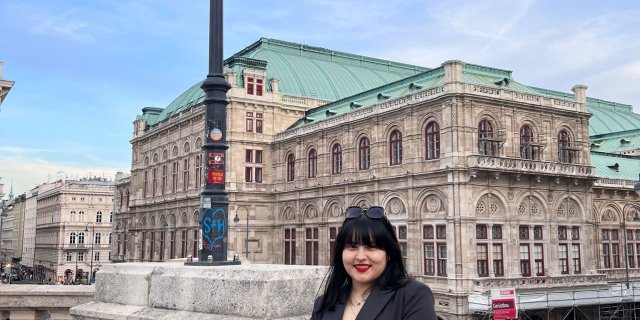Visual Culture and Art History

deadline
Understand the visual world
The programme Visual Cultures and Art History provides advanced historical and theoretical analysis of art and other related forms of visual representation and communication, but situates that analysis within the wider field of cultural production, under the term "visual culture." In the last 30 years or so, the meaning and identity of "art" has been a central topic of investigation and, consequently, traditional practices of art history.
See the visuals in wider context
The programme takes such scrutiny as its starting point. Hence, while the study of works of art will form the backbone of the programme, traditional stylistic, iconographic, semiological, and aesthetic modes of analysis (and their assumptions) will be viewed in the light of other modes of inquiry.
Understand other cultures
The primary focus is on Mediterranean, Caucasian, Euro-American art and visual cultures, but students will also be encouraged to engage with wider theories of globalisation and their pertinence for understanding economies of visual representation. This will include both specifically post-colonial perspectives to wider methods addressing issues in cross-cultural analysis.
This programme is divided into two main study directions: a more traditional teaching of lectures and seminars and interactive teaching including laboratories of humanities and professionalising activities. The student writes a Master’s thesis based on the relevant coursework. All teaching, coursework, and exams in this study programme are carried out in the English language.

Graduate profile
Graduates with this degree are capable of complex understanding of visual studies. They have a deep knowledge of premodern and modern visual and material culture, art history, and the role of images for societies across the globalised world. A graduate can analyze and interpret chosen issues related to visual studies in individual or group outputs, which can be professional (scholarly research; professional lecture) or popularising (essay; blog post; popularising publications; public lecture). Proposing a broader spectrum than traditional art history, graduates can be trained for research, cultural mediation, media, publishing, curatorship, and policymaking, as well as any profession that demands the ability to think and express themselves independently and critically.
Admission requirements
Eligibility Criteria
This degree program is open to:
- Students of the Department of Art History at MU who have had excellent results in the defense of their Bachelor's thesis (evaluation A–B) are admitted to the follow-up master's program without admission interview.
- If a student from another programme or another university applies, he/she should present a written motivational letter, explaining the reasons for his/her interest to study at the Department of Art History. Furthermore, he/she must have successfully defended a B.A. in art history or in other related disciplines, with an excellent evaluation of his/her thesis (A–B), and with a focus on the Mediterranean, Caucasian, Euro-American art and visual cultures. He/she will then undergo an oral examination by a committee of the Department of Art History professors.
- Terms of Admission
- Entrance exam
The evaluation of the applications will be done in two steps:
- Evaluation of the submitted documents (Motivation letter, B.A. thesis in format PDF, a written evaluation of the thesis by the supervisor, copy of the B.A. or equivalent degree).
- Interview: During the interview, the candidate will present her/himself as well as her/his intellectual path. The general assessment of the commission is based on the overall evaluation of the following criteria:
- The candidate will explain the reasons for her/his decision to join the Department of Art History at MU, she/he should show her/his familiarity with the research and intellectual objectives of the Department and its units.
- The interview will be held in English, but at least passive knowledge of the other main languages of scholarly research in the visual arts, i.e., German, Italian, French, and possibly Spanish and Russian are additional positive points.
- The evaluation of the student's written Bachelor’s thesis at her/his home institution also has informative value for admission;
part of the admissions procedure is the determination of the specialisation the student chooses and a project assessment of the future MA thesis. For this last point, the admission procedure features a brief defense of the intended further and a presentation of the potential thesis project.
- The candidate will explain the reasons for her/his decision to join the Department of Art History at MU, she/he should show her/his familiarity with the research and intellectual objectives of the Department and its units.
Application deadlines
1 January–30 April for the enrollment in the Fall semester
1 July–31 October for the enrollment in the Spring semester
Documents set out above in the Terms of Admission are required to be provided in digital form and attached to the online application by 30 April or 31 October.
Student Ambassador
 Andrea Pérez Belmont
Andrea Pérez Belmont

Other study programmes

deadline
(academic year)

deadline
(academic year)

deadline
(academic year)




